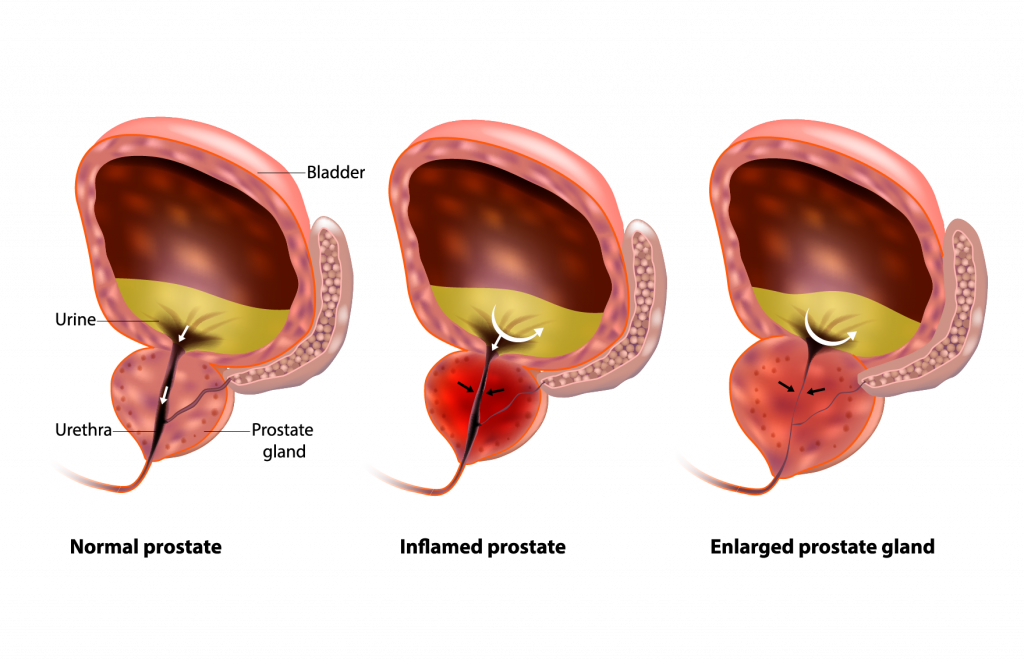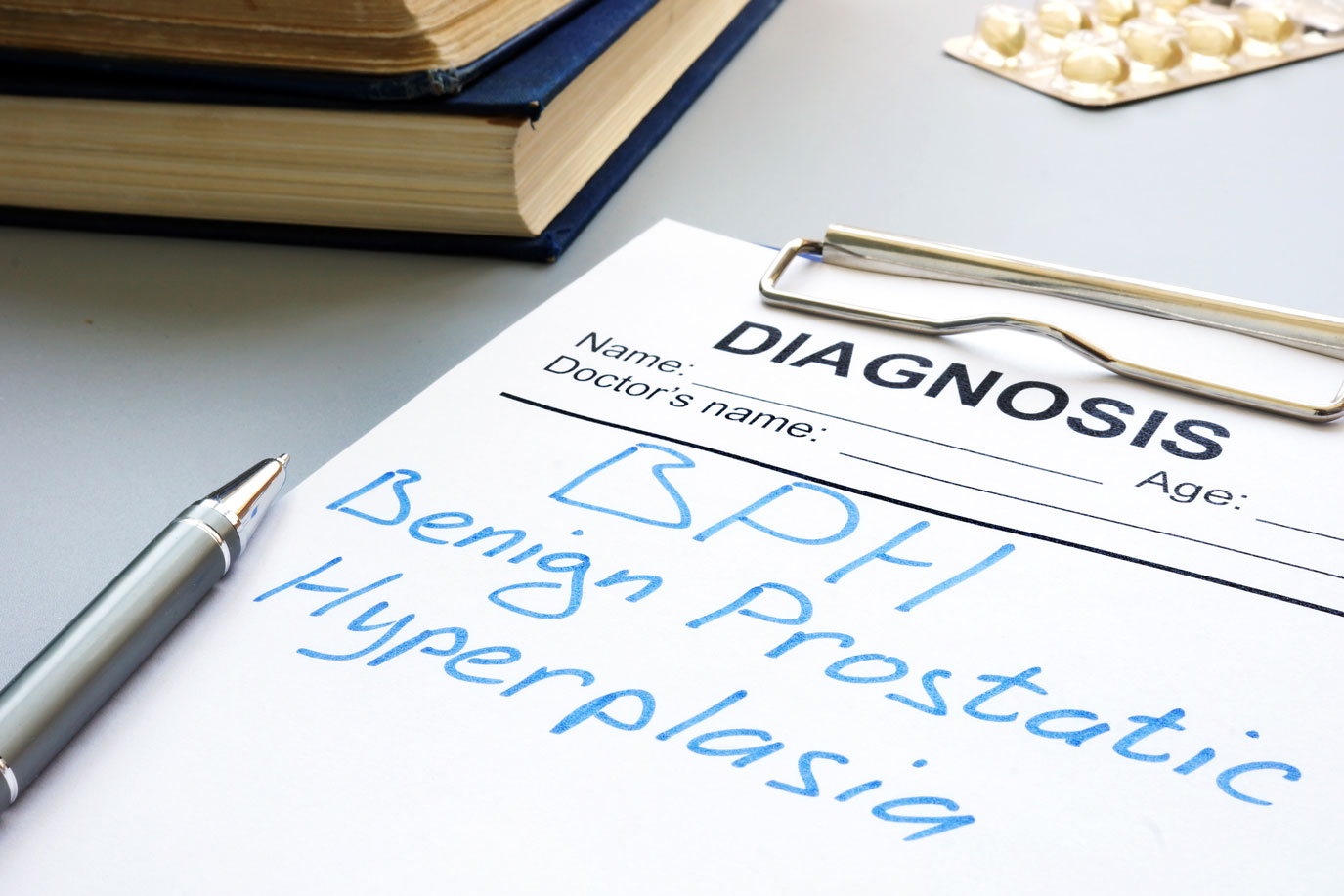Surgery, Medical Management of BPH
Medical Management
When BPH needs to be treated, the first thing that is trying is a modification of lifestyle factors. There may be food restriction past a certain time at night if your symptoms involve urinating very frequently overnight, and withholding of caffeine and stop smoking are quite effective as well. Should these Maneuvers not help the symptoms, there are pelvic floor exercises, biofeedback, as well as other lifestyle modifications, are possible. When these basic maneuvers do not help, often medication is necessary. The following medications may be indicated:


Medication
- Alpha blockers. These medications act directly at the level of the bladder neck and relax the muscles making urination easier. Common medications we use include Xatral,Cardura, Flomax and Rapaflo. While these medications are really well-tolerated, minimal side effects may occur including dizziness and a harmless condition in which upon ejaculation, the man’s semen goes backward into the bladder, called retrograde ejaculation
- 5-alpha reductase inhibitors. These medications shrink your prostate by Acting on an enzyme the prostate that changes the hormonal balance. By doing this, further growth the prostate is prevented. Common medications in this class include Proscar and Avodart — might take up to six months to be effective. Side effects include retrograde ejaculation.
- Combination drug therapy. Your doctor might recommend taking an alpha blocker and a 5-alpha reductase inhibitor at the same time if either medication alone isn’t effective. Studies as early as the MTOPs study in 2000 to support the use of these medications in combination due to their additive effect and very good tolerance with minimal side effects.
- Tadalafil (Cialis). all this medication is known for its helpful effects for men suffering from erectile dysfunction, Studies suggest this medication, also have demonstrated that it can treat prostate enlargement. this is an effective treatment for men suffering from both benign prostatic hyperplasia and voiding dysfunction as well as concomitant erectile dysfunction and can be added to other classes of medications for additive effect
Minimally invasive or surgical therapy
A medical therapy and conservative measures do not work, we often move towards minimally invasive surgical approaches to deal with major symptoms, or with complications that have occurred due to BPH. Surgical approaches may be recommended if there is a patient preference for definitive management and if the medications haven’t helped with symptom control. many men prefer to definitively manage this to be off medications for the rest of their life. It is important to note, that there are associated conditions with BPH that need to be treated first before we can treat BPH effectively. There may also be mitigating circumstances such that minimally invasive therapies may not be indicated. While, these surgical approaches are generally very well tolerated, there are generalized symptoms and side effects that need to be understood by the patient in order to move forward. These symptoms include retrograde ejaculation, prolonged recovery after surgery, urinary tract infection, bleeding, erectile dysfunction, and extremely rarely, urinary incontinence ( inability to hold urine in leading to involuntary loss).
Any type of prostate procedure can cause side effects. Depending on the procedure you choose, complications might include:
- Semen flowing backward into the bladder instead of out through the penis during ejaculation(retrograde ejaculation)
- Temporary difficulty with urination
- Urinary tract infection
- Bleeding
- Erectile dysfunction
- Very rarely, loss of bladder control (incontinence).
There are several types of minimally invasive or surgical therapies.
Transurethral resection of the prostate (TURP)
A lighted scope is inserted into your urethra, and the surgeon removes all but the outer part of the prostate. TURP generally relieves symptoms quickly, and most men have a stronger urine flow soon after the procedure. After TURP you might temporarily need a catheter to drain your bladder.
Transurethral incision of the prostate (TUIP)
A lighted scope is inserted into your urethra, and the surgeon makes one or two small cuts in the prostate gland — making it easier for urine to pass through the urethra. This surgery might be an option if you have a small or moderately enlarged prostate gland, especially if you have health problems that make other surgeries too risky.
Transurethral microwave thermotherapy (TUMT)
Your doctor inserts a special electrode through your urethra into your prostate area. Microwave energy from the electrode destroys the inner portion of the enlarged prostate gland, shrinking it and easing urine flow. TUMT might only partially relieve your symptoms, and it might take some time before you notice results. This surgery is generally used only on small prostates in special circumstances because re-treatment might be necessary.
Transurethral needle ablation (TUNA)
In this procedure, a scope is passed into your urethra, allowing your doctor to place needles into your prostate gland. Radio waves pass through the needles, heating and destroying excess prostate tissue that’s blocking urine flow. TUNA may be an option in select cases, but the procedure is rarely used any longer.
Laser therapy
A high-energy laser destroys or removes overgrown prostate tissue. Laser therapy generally relieves symptoms right away and has a lower risk of side effects than does nonlaser surgery. Laser therapy might be used in men who shouldn’t have other prostate procedures because they take blood-thinning medications.
The options for laser therapy include:
- Ablative procedures. These procedures vaporize obstructive prostate tissue to increase urine flow. Examples include photoselective vaporization of the prostate (PVP) and holmium laser ablation of the prostate (HoLAP). Ablative procedures can cause irritating urinary symptoms after surgery, so in rare situations another resection procedure might be needed at some point.
- Enucleative procedures. Enucleative procedures, such as holmium laser enucleation of the prostate (HoLEP), generally remove all the prostate tissue blocking urine flow and prevent regrowth of tissue. The removed tissue can be examined for prostate cancer and other conditions. These procedures are similar to open prostatectomy.
Prostatic urethral lift (PUL)
Special tags are used to compress the sides of the prostate to increase the flow of urine. The procedure might be recommended if you have lower urinary tract symptoms. PUL also might be offered to some men concerned about treatment impact on erectile dysfunction and ejaculatory problems, since the effect on ejaculation and sexual function is much lower with PUL than it is with TURP.
Embolization
In this experimental procedure, the blood supply to or from the prostate is selectively blocked, causing the prostate to decrease in size. Long-term data on the effectiveness of this procedure aren’t available.
Open or robot-assisted prostatectomy
The surgeon makes an incision in your lower abdomen to reach the prostate and remove tissue. Open prostatectomy is generally done if you have a very large prostate, bladder damage or other complicating factors. The surgery usually requires a short hospital stay and is associated with a higher risk of needing a blood transfusion
TREATMENTS & CONDITIONS
Surgery for Prostate Cancer
Surgery for prostate cancer can be curative while preserving urinary and sexual function. A prostatectomy can often be performed using robotic techniques, but traditional surgery

Surgery for Kidney Cancer
Surgery for kidney cancer can be personalized to the anatomy of the kidney and the location of the tumor. Often, only the tumor and a healthy rim of normal tissue can be removed,

Surgery for Bladder Cancer
This surgical procedure is used in both the diagnosis and treatment of bladder cancer. And TURBT allows Dr. Feifer to remove an entire tumor from the inside of your bladder.

Surgery for Testicular Cancer
The standard of care for the removal and treatment of testis cancer is a radical inguinal orchiectomy, After having been properly


